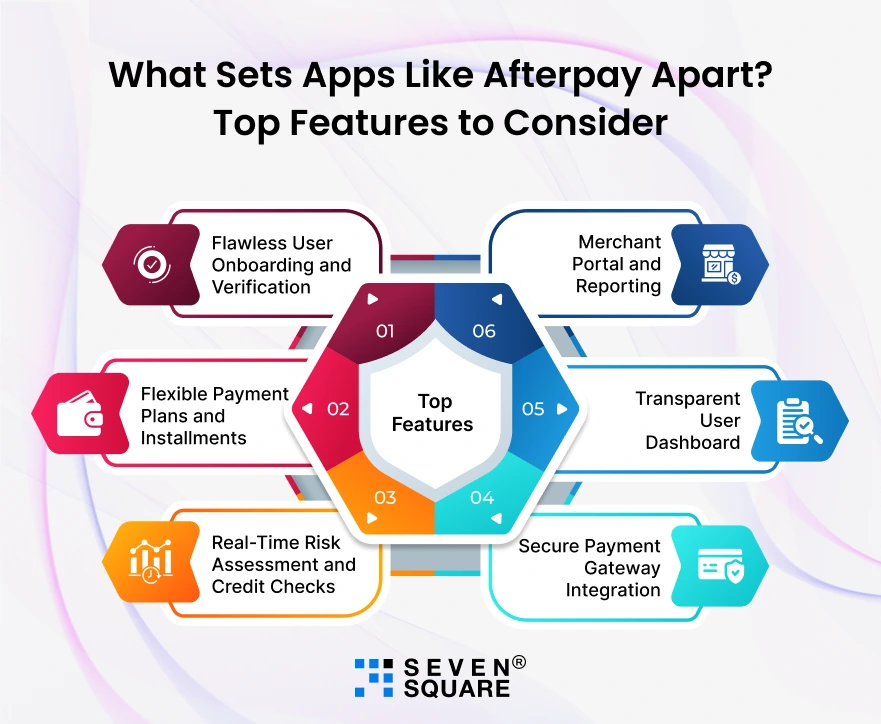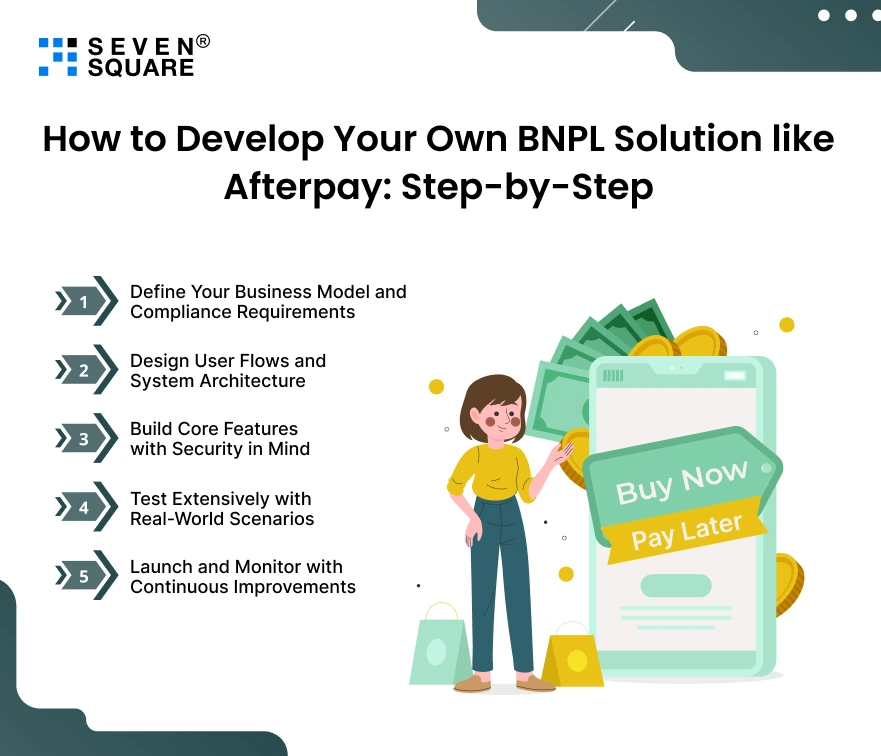Imagine you’re a founder of an e-commerce or fintech business.
You’ve noticed the rise of Buy Now Pay Later (BNPL) apps like Afterpay everywhere.
Customers love the flexibility, and businesses are seeing higher conversions.
But when you start digging into the “how,” it quickly becomes clear: building a BNPL app that works securely, flawlessly, and at scale is a challenge.
We get it. We’ve built custom BNPL solutions for different industries over the years.
Are you thinking about how to build apps like Afterpay, or wondering what makes these BNPL solutions tick?
In this blog, you can learn about the top features of apps like Afterpay and what you need to consider when developing your own BNPL solution.
By the end, you’ll have a clear picture of the real requirements and how to make smart decisions for your product.
Why Apps Like Afterpay Are a Game-Changer?
Before diving into development, let’s see why BNPL apps like Afterpay are disrupting traditional payment systems.
Buy Now Pay Later apps give shoppers the option to split their purchases into interest-free installments.
This flexibility drives conversion, reduces cart abandonment, and attracts younger, budget-conscious customers.
Businesses get faster sales and better cash flow without upfront discounts or complicated credit checks.
But the magic lies under the hood.
The technology powering these apps must handle complex risk assessments, seamless payment integrations, regulatory compliance, & a smooth user experience.
Also, learn about strategies to reduce cart abandonment in Shopify.
What Sets Apps Like Afterpay Apart? Top Features to Consider

If you want to build apps like Afterpay, your solution must include core features that make BNPL apps reliable, user-friendly, and scalable.
Here’s you can see the necessary features based on our experience developing BNPL app solutions for multiple industries:
1. Flawless User Onboarding and Verification
Afterpay’s smooth onboarding starts with quick user registration and verification. This often includes:
- Mobile number/email verification
- Basic KYC (Know Your Customer) compliance checks
- Integration with identity verification APIs
At Seven Square, we emphasize swift onboarding flows that minimize friction.
Complex or slow registration kills conversion, so it’s critical to balance compliance with usability.
2. Flexible Payment Plans and Installments
The core appeal of BNPL apps is flexible installment options, usually interest-free payments spread over weeks or months. Your app should allow users to:
- Choose installment plans at checkout
- View upcoming payment schedules
- Receive automated reminders and alerts
Your backend must calculate installments accurately, handle partial payments, and sync payment status in real time.
3. Real-Time Risk Assessment and Credit Checks
Apps like Afterpay use data-driven algorithms to assess the risk of lending to a shopper.
This risk assessment happens instantly during checkout to approve or decline the transaction.
Developing a reliable BNPL app means integrating:
- Credit scoring models or third-party credit bureaus
- Fraud detection systems
- Custom risk algorithms tailored to your business needs
We’ve built custom risk engines at Seven Square that align perfectly with each client’s tolerance and regulatory requirements.
4. Secure Payment Gateway Integration
A BNPL solution is only as good as its payment infrastructure. You need flawless integration with payment gateways and processors to:
- Collect installments securely
- Handle refunds or disputes
- Manage multiple payment methods (cards, wallets, UPI, etc.)
Security here isn’t optional. PCI compliance and data encryption must be baked in from day one.
We did Razorpay integration in an app, and we can do the same while building your Afterpay like app.
5. Transparent User Dashboard
Apps like Afterpay keep users engaged with clear, real-time dashboards showing:
- Purchase history
- Outstanding balances
- Next payment due dates
This transparency builds trust and reduces missed payments. Your app should offer an intuitive UI/UX that customers can navigate smoothly.
6. Merchant Portal and Reporting
Don’t forget the merchant side. BNPL apps need dashboards for businesses to:
- Track transaction status
- Manage orders and refunds
- View customer analytics and payment trends
Our experience includes building robust merchant portals that help business owners with actionable insights.
How to Develop Your Own BNPL Solution like Afterpay: Step-by-Step

If you’re ready to develop a BNPL solution like Afterpay, here’s a straightforward roadmap from our team’s perspective:
Step 1: Define Your Business Model and Compliance Requirements
BNPL regulations vary by region. First, define:
- Your target market and customer demographics
- Regulatory requirements (KYC, data privacy, credit laws)
- Risk tolerance and underwriting policies
This step shapes your entire product design and technology choices.
Step 2: Design User Flows and System Architecture
Sketch out clear user journeys like onboarding, shopping, payment, & dashboard use. Then, architect the backend to support:
- Scalable, secure transaction processing
- Real-time data sync between user and merchant interfaces
- Integration with third-party services (credit bureaus, payment gateways)
At Seven Square, we believe early architectural clarity prevents costly refactors.
Step 3: Build Core Features with Security in Mind
Start coding your app with a focus on:
- Data security and encryption
- Real-time risk and credit evaluation modules
- Payment processing and installment management
Our development team avoids bloated code or over-engineering, just what works reliably.
Step 4: Test Extensively with Real-World Scenarios
Testing BNPL apps involves:
- Load testing to simulate transaction surges
- Security penetration testing
- User acceptance testing for flawless UI/UX
Our swift delivery model includes parallel testing and continuous feedback loops to speed up launch without compromising quality.
Step 5: Launch and Monitor with Continuous Improvements
After launch, monitor:
- User behavior and payment defaults
- System performance and error logs
- Regulatory updates and compliance checks
Iterate quickly based on data; this agile approach keeps your BNPL app competitive and reliable.
The Tech Stack Behind Apps Like Afterpay
Choosing the right technology stack is critical. Popular BNPL apps typically use:
- Backend: Node.js, Python (Django/Flask), or Java Spring Boot
- Frontend: React Native or Flutter for mobile apps; React or Angular for web portals
- Databases: PostgreSQL, MongoDB for transactional and user data
- Payment APIs: Stripe, Adyen, or custom gateway integrations
- Risk & Fraud: Custom algorithms enhanced by AI/ML frameworks
Our team at Seven Square has hands-on experience integrating all these layers efficiently, balancing speed and scalability.
Why Seven Square for Your BNPL App Development?
With years of delivering custom BNPL solutions across fintech, retail, and beyond, Seven Square offers:
- Swift delivery cycles with clear communication at every step
- Uncompromising quality standards ensure secure, scalable solutions
Our developers are helping founders to make smart, informed decisions.
We’re here to build practical & reliable apps like Afterpay that drive real business results.
Want to build a custom BNPL app like Afterpay? Contact Us Now!
Cost Factors for Developing BNPL Apps Like Afterpay
Building a Buy Now Pay Later app like Afterpay isn’t cheap, but costs vary based on:
- Features complexity (e.g., advanced credit risk models add cost)
- Compliance requirements in your operating regions
- Scale expectations and user base size
- Ongoing maintenance and support
A solid app like Afterpay might cost around $20k to $35k, but expect higher investment for enterprise-grade solutions with custom integrations.
FAQs
- BNPL (Buy Now Pay Later) apps like Afterpay let customers purchase items and pay in installments, often interest-free.
- These apps offer a flexible alternative to credit cards and are widely integrated into e-commerce platforms to boost conversion and customer satisfaction.
- Apps like Afterpay typically earn revenue through merchant fees (charged to businesses for each transaction) and late fees (charged to customers who miss payments).
- Unlike traditional lenders, most BNPL platforms don’t charge interest to users for on-time payments.
- To build a BNPL app like Afterpay, start by defining your business model and compliance needs.
- Then design user flows, develop key features like risk assessment and installment tracking, and integrate secure payment gateways.
- Partnering with a team like Seven Square can help you build a scalable, compliant, and user-first solution from the ground up.
- Yes, BNPL apps are increasingly regulated across regions due to their credit-lending nature.
- Regulations may include KYC/AML compliance, consumer protection laws, and data privacy requirements.
- It’s necessary to build your app with local compliance in mind from the start.